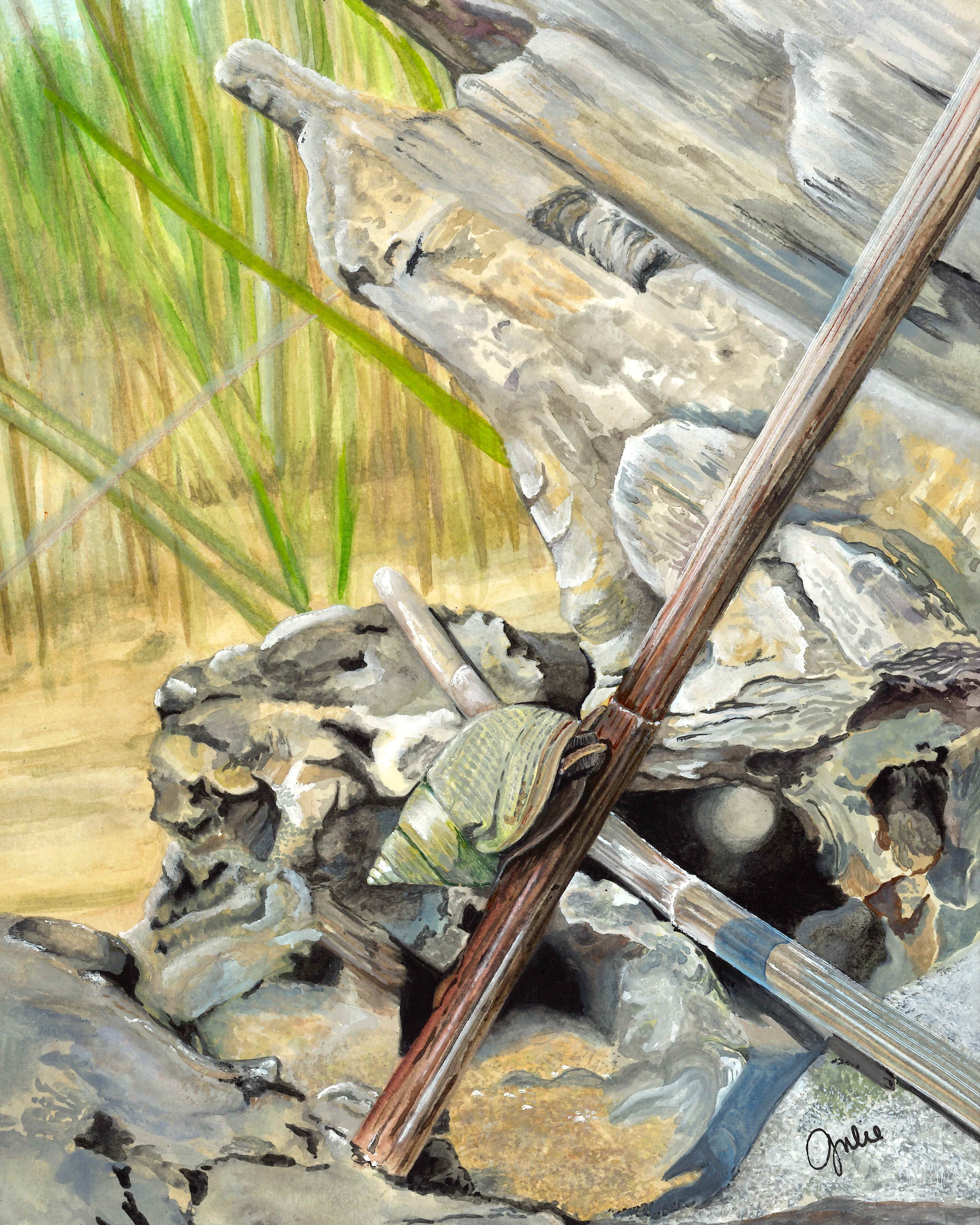Appearance and Habitat
The marsh periwinkle (Littoraria irrorata Say, formerly Littorina irrorata) is a small and slow-growing snail that over the course of a decade may reach sizes little more than 2 centimeters (about ¾ of an inch). Its scientific name translates to "dewy shore-dweller”, reflecting its preferred habitat of salt marshes. As with other snails, it has a hard spiraling shell and a tight-fitting door-like structure called an operculum that allows it to fully retract and seal itself off, providing protection from predators, desiccation, and temperature extremes. Its coloration ranges from gray-white to tan, though it can also display a greenish tinge from algae growing on its surface.
After starting life in a planktonic larval stage, young Littoraria settle into the furled leaves of the cordgrass, Spartina alterniflora. Their muscular foot, characteristic of gastropods, enables both locomotion across various substrates and secure attachment to vegetation through mucus secretion. Though marsh periwinkles can be found on the leaves of most salt marsh vegetation, they exhibit a preference for cordgrass (Spartina alterniflora). Marsh periwinkles are extremely common throughout the entire range of this coastal grass.
Cordgrass grows at low elevation such that its roots and lower stems are typically flooded twice a day. These rising tides bring in not just water, but also the periwinkles' primary predators, which include blue crabs, mud crabs, terrapins, and various fish species. To escape these threats, adult marsh periwinkles climb up on the cordgrass stems and leaves, which is where you would typically catch a glimpse of them.
Just how many marsh periwinkles might you find in a typical salt marsh? Their distribution can be patchy, and their abundance depends on many factors, including predation. One study found between 20 and 70 individuals of at least 1 centimeter height could be found per square meter of salt marsh (Graca et al. 2000). If we scaled this to human proportions, the upper end of this range would be roughly similar to Baltimore’s population density or a little less dense than Washington DC. That makes them quite abundant, though not packed in like some of the world's densest cities.
Fungus Farming
What does the marsh periwinkle feed on? This question reveals a fascinating aspect of their ecology, one that took numerous studies to uncover. Early research identified that marsh periwinkles prefer feeding on decaying rather than fresh green cordgrass. Part of that seasonal decay process involves decomposition by fungi, and early studies estimated that decaying plant material by the end of the season may be composed of as much as 20% fungal material rather than plant material alone (Graca et al. 2000). Further observations revealed that marsh periwinkles actually prefer to feed on the fungal material itself over the harder-to-digest marsh vegetation.
The periwinkle's response to this preference is remarkable: it actively cultivates its preferred food using the cordgrass as a growing medium. The snails use their rasping radula to create wounds on the cordgrass stems. They then eliminate their waste, which is rich in nutrients and fungal material from their previous meals, directly onto these wounds. Through this deliberate tending, planting, and fertilizing, the snails grow their own garden of fungus. This behavior can be called fungus farming or gardening, or in technical ecology terms, "facilitation of fungal invasion." This discovery represented among the first demonstrations of fungal garden-tending behavior outside of insects (Silliman and Newell 2003).
While cordgrass does not benefit from this farming practice, it appears to be an unavoidable consequence of its role as the dominant vegetation in marshes. Unless snail populations become extremely dense (Silliman and Newell 2003), this farming behavior does not appear to significantly limit marsh growth or production (Kiehn and Morris 2009). Instead, it creates an important pathway for marsh biomass to enter the food web: cordgrass provides substrate for snail farming, which cultivates fungus, which feeds the snails, which become prey for crabs and other animals.
We hope you’ll take this water color image as an invitation to go out and visit a salt marsh. Take a closer look at those humble marsh periwinkles, which you’re sure to find clinging to cordgrass stems. You’ll be witnessing sophisticated farmers at work, tending their microscopic crops in one of Earth's most productive ecosystems.
Looking for More Information?
Chesapeake Bay Program: https://www.chesapeakebay.net/discover/field-guide/entry/marsh-periwinkle
Klinges DH, Martin CW, Roberts BJ. 2025. Ecological associations of the coastal marsh periwinkle snail Littoraria irrorata: field and laboratory evidence of vegetation habitat preferences. PeerJ 13:e19071 https://doi.org/10.7717/peerj.19071
Kiehn, W. M. and J. T. Morris. 2009. Relationships between Spartina alterniflora and Littoraria in a South Carolina salt marsh. Wetlands 29: 818-825.
Silliman, B. R. and S. Y. Newell. 2003. Fungal farming in a snail. Proceedings of the National Academy of Sciences. 100: 15643–15648.
Silliman, B. R. and J. C. Zieman. 2001. Top-down control of Spartina alterniflora production by periwinkle grazing in a Virginia salt marsh. Ecology 82:2830–45
Graca, M.A., S. Y. Newell, and R. T. Kneib. 2000. Grazing rates of organic matter and living fungal biomass of decaying Spartina alterniflora by three species of salt-marsh invertebrates. Marine Biology 36: 281-289.


